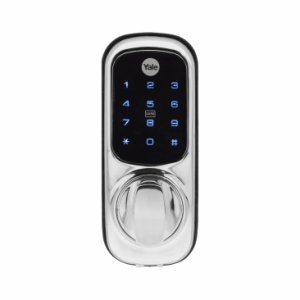Are Digital Locks More Secure Than Traditional Locks?
In modern times there is no doubt that we are more security conscious and we put more value on our own safety, security and privacy. After all, we have locks on everything; our doors, our phones and on the online shopping websites we visit. But as with most things that technology has developed and evolved, there is conjecture as to whether digital locks are more secure than traditional locks.
What is the difference between digital locks and traditional locks?
First of all we need to understand the distinction between digital locks and traditional locks, before we can establish which method is more secure.
Traditional locks – these are locking systems that are manually engaged and non-automated. In simple terms you need a key to operate and open the lock.
Digital locks – these are a digital version of a traditional lock and the locking mechanism is engaged in an automated fashion, using either a PIN code, keycard/fob, biometric feature or a smartphone app. Hence, a digital lock can be engaged with remotely.
How do digital locks work?
The important thing to understand when looking at the difference between digital locks and traditional locks, is that digital locks are just an automated version of a traditional lock, and hence they use the same type of locking mechanism. This could be a mortice lock, a deadbolt or a rim cylinder lock. So in a physical sense, digital locks are just as secure as traditional locks because they use exactly the same method of locking a door.
However, where digital locks can offer more security than traditional locks is in how they are activated, their convenience, and the additional security features some of them offer.
Why digital locks are more secure than traditional locks
There are a number of reasons why digital locks are more secure than traditional locks, so let’s look at these now:
- Keys – A physical key can be lost or stolen, and it can be copied. This leaves your home or business vulnerable to opportunist thieves or unauthorised people. While a physical keycard or fob can also be lost or stolen, a digital locking system can be quickly altered so that particular card or fob will no longer be able to gain access.
- Automated locking – We have all been in the situation where we have rushed out of the door for work or to catch a bus and a few minutes later have panicked because we couldn’t remember locking the door. With a traditional door lock you won’t know for sure whether you have or not until you physically return home, and by then it could be too late. Some models of digital lock will automatically engage if a door is left unlocked for a specified period of time, usually set to a few seconds, and hence, even if you have left the door unlocked, you know it will automatically lock itself.
- Picking – Most traditional locks are vulnerable to picking, and because the locking mechanism is standard and therefore the same, someone who knows what they are doing can apply the same method of picking the lock to many different locks. Digital locks are far more secure because there are no accessible parts, there is no keyhole and there are fewer ways for someone to physically tamper with a lock. It is possible to ‘hack’ a smart lock, ie. to access the digital system that communicates with the lock through a smartphone app, but cracking an encryption is a specialist skill and takes time to do, so it is unlikely to be carried out by an opportunist thief. Furthermore, a system being hacked would trigger smartphone alerts, so the person could react via their smartphone from a remote location.
- Authorisation – While a key can be copied so that someone can gain unauthorised access, it is much easier to control who has the knowledge of individual PIN numbers or passcodes. These can also be changed if a security breach is suspected. Keycards and fobs can be swapped, shared or stolen, but can also be stopped very quickly, and of course biometric features are unique to one person. If you wish to restrict access to that person then you can very quickly do that through the system. Smartphone activated locks are very easy to manage in terms of authorisation, you can update to new software to help avoid hacking and you can change numbers and access methods very easily through the smartphone app.
The benefits of digital locks
Depending on the type of activation method you use for your digital lock, there are typically many advantages to having one, and these can be linked to an enhanced level of security also:
- You have visibility of who has accessed a site and when
- You can issue different codes or numbers to different people to avoid the risk of duplication
- You can receive notifications and alerts when the building has been accessed.
In summary, digital locks are just as secure as traditional locks because they use the same types of physical locking mechanism, however, they offer far more sophisticated and convenient levels of security through the method of activating the lock and how this authorisation can be controlled.